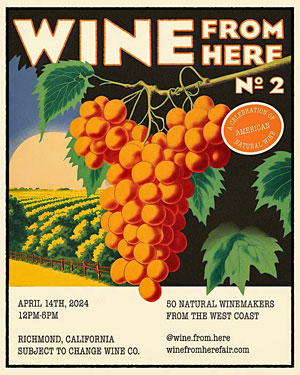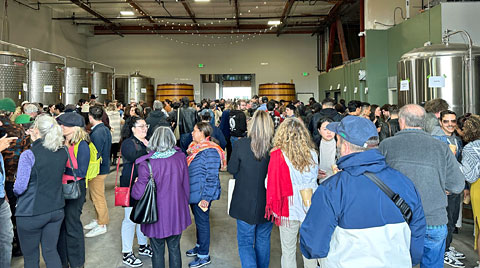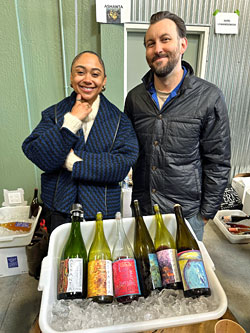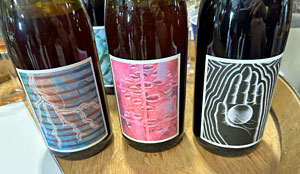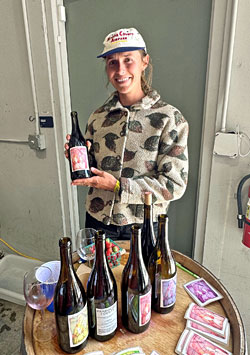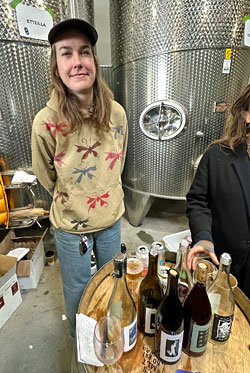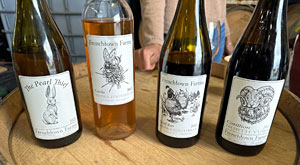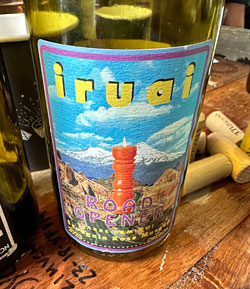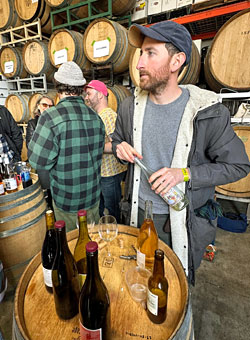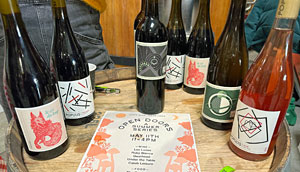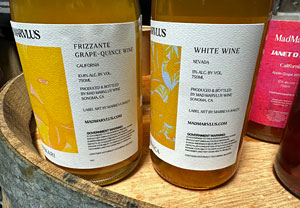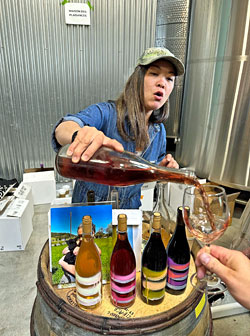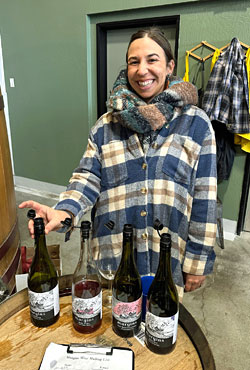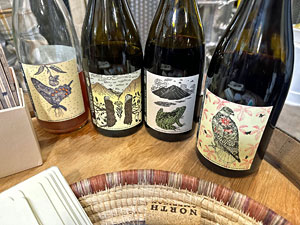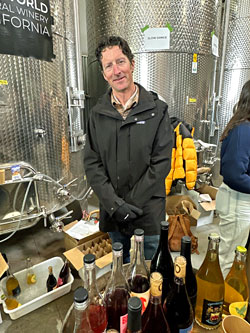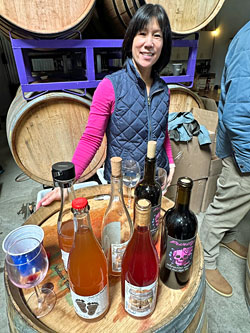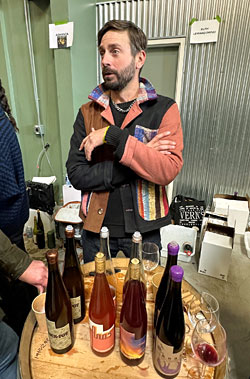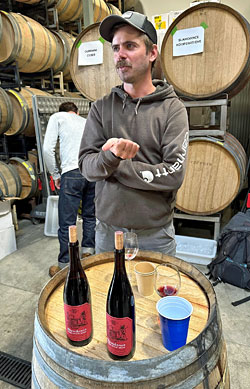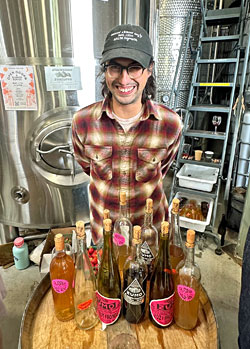Ashanta Wines
Chenoa Ashton-Lewis & Will Basanta made their first wine in 2019 and launched Ashanta Wines the following year. They make their wines in Sebastopol. The 2022 “Mermejita” is a blend of Viognier with skin-contact Marsanne, sourced from a higher-elevation vineyard in San Diego County and aged in neutral oak. This had pear and stone fruit, orangepeel, and spice aromas and a pleasant texture. Another favorite here was the 2022 “Methuselah” – about 50% old-vine Grenache from the Santa Cruz Mountains plus 25% each Mission from Russian River Valley and Carignan from Mendocino County – which featured earthy red fruit and spice, with medium body and plenty of structure.
Caleb Leisure Wines
Caleb worked at wineries in France and California before starting his own label in 2016. He makes his wines in Cloverdale, and most of them are made in traditional Georgian qvevri. The 2022 “I Got It Bad” is a skin-fermented Pinot Gris, with five-week maceration – this had slightly higher-toned stone fruit, spice, and orangepeel aromas with a lively medium-light texture. I also enjoyed the 2021 “Other Hand,” about 75% Cabernet Sauvignon and Merlot, plus Cabernet Franc and Petit Verdot, all whole-cluster fermented. Displaying lots of spice plus both red and black fruits, medium weight on the palate and firm tannins, this could use a bit more time in the cellar to show its full potential.
Clos Saron
Based in Yuba County in the northern Sierra Foothills, Clos Saron’s Gideon Beinstock has been a longtime proponent of natural winemaking. One of my favorites here was the 2020 “Kind of Blue,” a co-ferment of about 3/4 Cabernet Franc and 1/4 Syrah. The Cab Franc component took the aromatic lead, with herbal plum and currant fruit, plus a medium-full mouthfeel and firm tannins. Gideon often releases older vintages of his wines, and the 1999 “Once Upon A Time” Cabernet Sauvignon was a fine example, still showing bright currant fruit plus slightly smoky dried herb notes, great texture and good structure – a very nice older Cab.
Ellsworth Wines
Vintners Bryn Molloy & Jeffrey Ellsworth farm several vineyards and make their wines in Nevada County in the northern Sierra Foothills. I enjoyed the 2022 Skin-contact Chardonnay from Mendocino County, which spent two weeks on the skins – this had spice and apple aromas with medium body and a pleasant texture. The 2021 Cabernet/Merlot Red Table Wine, with fruit sourced from Nevada County and Yuba County, is about 65% Cabernet Sauvignon. With black cherry fruit, earth, spice, and herbal undertones, this was medium-light bodied with moderate tannins.
Etteilla Wines
Anne Disabato and Noelle Vandendriessche both worked for Tony Coturri before launching their own label, and they make their wines in Sonoma County. I particularly liked the 2022 “Tibbar” Pinot Noir from Sonoma Valley, made with whole-cluster fermentation. This had bright red fruit with herbal and earthy notes, good acidity, and a lively finish.
Florèz Wines
Owner/winemaker James Jelks makes his wines in Watsonville and works largely with fruit from the Santa Cruz Mountains but also sources from other old organically-farmed vineyards. A favorite was the 2023 “Shangra-li Mendo Savvy B” Sauvignon Blanc, made with a little skin contact. With aromas of citrus and tropical fruit, fresh herbs, and a floral note, this showed great purity of fruit and a vibrant texture. The 2022 “Noble Oble” Santa Cruz Mountains Pinot Noir featured earthy and herbal black cherry fruit with fine acidity and structure. Another highlight was the 2022 “Monsieur Mysterieux” Cabernet Pfeffer from Gimelli Vineyard in Cienega Valley, aged for about 16 months in neutral oak. With peppery and earthy plum and darker berry fruit and a grippy tannic finish, this could use additional bottle age but has lots of promise.
Frenchtown Farms
Proprietors Aaron & Cara Mockrish were on hand to pour their wines, which they make in the northern Sierra Foothills. They farm part of an older vineyard in the area, and most of their fruit comes from there. The 2023 “Cecelia” Cabernet Sauvignon Rosé had bright red berry aromas plus spice and fresh herbs in support, with more texture than many rosé wines. I particularly enjoyed the 2023 “Quail Run” Cinsault-Counoise – a 50/50 blend of the two varieties – which blossomed with intense floral and red fruit aromas, medium body, and fairly mild tannins, a great candidate for near-term drinking.
Glassmaker Wine Co.
Jonathan Walton makes the Glassmaker wines in Forestville. He works with fruit from vineyards ranging from Sonoma to the Central Coast to Lodi. My favorite here was the 2022 Sangiovese from Gimelli Vineyard in Cienega Valley. With red fruit and earth plus spice notes, this had good acidity and a lively finish.
Iruai
Owner/winemaker Chad Hinds farms vineyards and makes his wine in far northern California, and gets some of his fruit from southern Oregon. The 2023 “Road Opener” Savagnin Rose Musqué (the grape variety is another name for Gewüztraminer) came from a vineyard in southern Oregon’s Rogue Valley and was skin-fermented. This had bright floral and stone fruit aromas with medium weight and a nice texture. I also enjoyed the 2022 “Blood + Flowers” Syrah sourced from Applegate Valley in southern Oregon and fermented entirely with whole clusters. Showing a meaty, savory character along with dark berry fruit plus earth and iron undertones, with medium-full body and firm tannins – this should be worth cellaring for further development.
La Clarine Farm
From El Dorado County in the Sierra Foothills, La Clarine Farm produces a number of distinctive varietals and blends from fruit grown in their area. Proprietors Hank Beckmeyer & Caroline Hoël poured their wines at the tasting. The 2022 “Rosé Alors” is 74% Mourvèdre along with Grenache and Counoise, all whole-cluster pressed – this had intense floral and stone fruit aromas with a lively texture and finish. The 2022 Amber, made with about 1/3 direct-pressed Petit Manseng and 2/3 skin-fermented Grenache Blanc, featured citrus, tropical fruit, and orangepeel notes with a slightly chalky texture. I also enjoyed the 2022 “Return of the Son of Funky Drummer” Grenache/Mourvèdre – the original “Funky Drummer” was from 2017. This was super savory, with dried herb notes along red fruit and earth, medium-bodied with firm but approachable tannins – nice now but worth cellaring too.
La Onda
Vintner Dani Rozman of La Onda sources most of his fruit from the northern Sierra Foothills and makes his wines in Richmond. I particularly enjoyed the 2021 “Tinto Americano” blend of Cabernet Sauvignon and País, important varieties in North and South America respectively. Showing both red and black fruits, spice, and earth aromas, this was medium-bodied with a firm tannic finish.
|
Les Lunes / Populis
Proprietors Shaunt Oungoulian and Diego Roig make their wine at their urban Bay Area facility in Richmond. The Populis 2023 Rosé – mostly from Zinfandel and Pinot Gris – had subtle watermelon and floral notes with bright acidity. I also liked the Populis 2022 “Wabi-Sabi” red blend that’s mainly Carignane and Zinfandel – this displayed earthy and spicy berry fruit and medium tannins, and should be good for near-term drinking.
Mad Marvlus Wines
Marreya Bailey is the owner/winemaker of Mad Marvlus and produces both wine – including from hybrid grape varieties – and cider. She makes her wines in Sonoma. My favorite of the Mad Marvlus wines was the NV “Makari,” a frizzante blend of three vintages, and including Pineapple Quince and skin-contact Muscat. This featured floral stone fruit and tropical fruit notes with a light and lively texture and fresh finish.
Maison des Plaisances
Proprietor Coral Wang makes her wines in Sonoma. Her hand-painted wine bottles are very distinctive. The 2023 Estate Carbonic Cabernet was a bright, lighter rendition of the variety that emphasized the plum and currant fruit along with some herbal notes and milder tannins. Although I didn’t hear what grape varieties went into the 2023 “280 Project” blend – from vines grown on a hillside in the southeastern part of San Francisco near the 280 freeway – it was bright, herbal, and delicious.
Margins Wine
Owner/winemaker Megan Bell launched her label in 2016, after working in wineries and vineyards in California, Oregon, New Zealand and the Loire Valley. She makes her wines in southern Santa Cruz County. I enjoyed the bright citrus and herb notes of the whole-cluster pressed 2023 Paicines Ranch Assyrtiko, which also showed an intriguing saline component. The 2023 Siletto Vineyard Counoise displayed intense floral and red fruit aromas with fine acidity and a lively finish. Fermented with destemmed fruit and aged in neutral oak (also as with the Counoise), the 2023 Paicines Ranch Grenache had a very savory aromatic profile plus red fruit and spice, with medium weight and great texture.
North American Press
The specialty of proprietor Matt Niess is working with native American grape varieties and hybrids. He makes his wines in Santa Rosa. The 2022 “Wild Card” Dry Sparkling Wild Grape Coferment from Sonoma County combines Gravenstein apples and native California grapes – this was lightly sparkling with fresh red fruit and stone fruit aromas. Another intriguing offering was the 2022 “The Mentor,” with fruit sourced from Douglas County, Nevada (just east of the Sierra). A field blend of Frontenac Noir and St. Croix with a little La Crosse, this had red fruit, earth, and spice on the nose with medium body.
Old World Winery
Owner/winemaker Darek Trowbridge’s winery is in Russian River Valley, and he comes from that region’s famed Martinelli family. He sources fruit from some vineyards planted over 100 years ago. I particularly liked the 2022 “Ecstatic Consciousness” from Sonoma County, a field blend of Zinfandel, Syrah, Merlot, and Abouriou (a variety once called Early Burgundy in California) from 120-year old vines. This had bright berry and spice aromas with savory undertones, medium weight on the palate, and moderate tannins.
Purity Wines
Vintners Noel Diaz & Barrie Quan make their wines in Richmond, and get their fruit from several Northern California regions, from Mendocino to the Sierra Foothills. My favorite here was the 2022 “Peace Love Happiness” Pét-nat of Gewürztraminer, Gravenstein apples, pluots, and blackberries, with floral tropical fruit and red fruit aromas, fine bubbles, and a bright, refreshing finish.
Ruth Lewandowski
Proprietor Evan Lewandowski sources much of the fruit for his wines from Mendocino County, and he makes his wines in Healdsburg. The 2023 “Anos” from Fox Hill Vineyard in Mendocino County combines Friulano, Trebbiano, and Montepulciano – three “ano” varieties. With floral strawberry and stone fruit aromas, it had a bright mouthfeel and finish. The 2023 “Cuvée Zero” Rosé – mostly Tinto Roriz, Souzão, and Touriga Nacional plus a little Sauvignon Blanc – had bright red fruit, herb, and earth notes with fine acidity and a lively texture. I also enjoyed the 2022 “Boaz” co-ferment of mostly Carignan and Grenache from Testa Vineyard in Mendocino, which displayed an earthy and somewhat rustic character with red fruit and pepper and a grippy tannic finish.
Slamdance Koöperatieve
Owner/winemaker Daniel Callan makes his wine in the Tin City complex just south of Paso Robles. He poured only one wine at the tasting but it was a standout, the 2021 “Native Wine of California” Red Blend. This mainly combines pre-Prohibition California varieties used in many older field blends (though in this case, they’re from separate vineyards) – mostly Valdiguié, Cinsault, and Négrette, along with others including Trousseau, Cabernet Pfeffer, and Orange Muscat. The wine featured bright red fruit with savory herbal notes, spice, and a lively mouthfeel and finish – nice now and should develop with some cellaring.
Stagiaire Wine
Stagiaire is the label of Brent Mayeaux, who makes his wines on Treasure Island in San Francisco Bay. The 2022 “Consistency in Chaos” Syrah from Sonoma Carneros was a highlight here – this displayed savory dark berry fruit with spice and black olive notes, a medium texture and lively finish. The 2021 “Let’s Get Fizzical” is a Blanc de Noirs from Pinot Noir fruit that was aged on the lees in bottle and disgorged after 2.5 years. Bright apple and pear fruit with earthy/leesy undertones and lively bubbles.
Zumo
Vintners are Diego Luis Perez and his wife Georgia Staples make their wine in the same Richmond facility as a number of other natural wine producers. My favorite here was the 2021 “Palm Fronds” amber wine, from a field blend of Verdelho, Sauvignon Blanc, and Pinot Gris from Contra Costa County. With subtle floral and stone fruit aromas and herbal notes in support, this had medium-light weight and a pleasant texture. |


